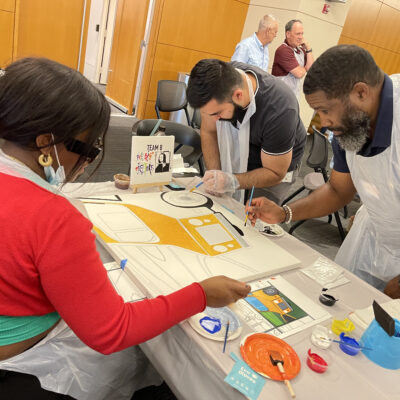Most companies still follow a familiar formula: top-down leadership, clearly divided departments, and little cross-pollination between teams. Marketing huddles with marketing, sales stick to sales, and decisions climb up and trickle down. It’s simple and predictable, and often wildly inefficient.
When teams stay in their corners, it creates barriers or “silos,” reducing communication and hindering creativity and momentum. Problems fall through the cracks, ideas stall, and collaboration becomes a buzzword instead of a practice.
Cross-functional collaboration is the antidote.
By bringing together people from different departments and backgrounds to chase the same goal, you get a team that sees more, solves quicker, and builds smarter. But what does cross-functional collaboration look like? Why is it so valuable? What challenges does it bring? And how can you set your team up for long-term success?
What is Cross-functional Collaboration?
A cross-functional team is a group of people from different departments, like marketing, operations, finance, sales, and product. They work together to solve a problem, complete a project, or share an objective. However, it’s not all about mixing job titles; it’s about blending perspectives.
Some cross-functional teams are project-based and temporary. Others operate like permanent hybrid squads. Some meet weekly, while others collaborate daily. Regardless of the setup, what makes these teams effective is the diversity of thought and creative prowess at the table.
But what is cross-functional collaboration exactly? Can we pinpoint it?
Picture the classic customer service nightmare: you call for help, get passed from one department to another, and still don’t have an answer.
This is an example of siloed thinking.
Now imagine the same call landing with a cross-functional team. One that includes someone from billing, someone from tech, and someone from customer service, all working together. The issue gets resolved in one sitting because the team isn’t guessing who owns the problem. They own it together.
That’s the power of cross-functional collaboration: fewer blind spots, faster solutions, and smarter outcomes.
How Cross-functional Collaboration Breaks Down Silos
In many organizations, departments operate like islands, focused on their own goals, processes, and priorities. This siloed structure can lead to miscommunication, duplication of effort, and a serious lack of visibility across teams. Cross-functional collaboration is one of the most effective ways to dismantle those barriers.
When people from different departments work together toward a shared objective, they begin to understand how their roles intersect. This naturally encourages knowledge sharing, builds empathy across functions, and improves overall efficiency.
For example, imagine a company launching a new product. Without cross-functional collaboration, marketing might promote features that engineering can’t deliver, while customer support is left out of the loop entirely. But in a cross-functional team, those departments collaborate from the start. Marketing knows what’s feasible, engineering understands user pain points, and support can prepare for incoming questions. The result is a more cohesive, successful launch.
Cross-functional collaboration breaks down silos by:
- Encouraging shared language and understanding across roles
- Revealing overlapping goals and dependencies
- Reducing bottlenecks through proactive problem solving
- Creating mutual accountability across departments
Another example: in healthcare settings, siloed departments can slow down patient care. But when administrative staff, nurses, physicians, and billing teams communicate openly in a cross-functional collaboration framework, they streamline processes and reduce delays in treatment and discharge.
Breaking down silos doesn’t mean dissolving departments. It means connecting them with purpose. Cross-functional collaboration helps team members see beyond their tasks and start thinking like contributors to a larger mission. That mindset shift transforms disconnected teams into a unified organization that moves faster, adapts better, and performs stronger across the board.
The Challenges of Cross-functional Team Collaboration
Mixing disciplines isn’t without friction. Cross-functional team collaboration introduces new dynamics, and a few headaches if you’re not prepared.
The biggest challenge? Communication. Different departments have different jargon, priorities, procedures, and workflows. What makes perfect sense to someone in product may sound like gibberish to someone in finance. Without a shared communication rhythm, misunderstandings can pile up, hindering employees’ ability to communicate effectively.
Then there’s the comfort zone problem. People naturally gravitate toward what (and who) they know. Asking employees to step outside their departmental bubble can stir up resistance, especially if they feel their expertise is being overlooked or their process is being disrupted.
Breaking down silos (or barriers) means breaking habits. It requires leaders who model cross-functional respect, tools that support open dialogue, and a workplace culture that values contribution over control. Otherwise, your collaboration will feel more like organized chaos.
The Benefits of Cross-functional Teamwork and Interdepartmental Collaboration
So, why is it worth pushing through the discomfort? Because when cross-functional collaboration clicks, it creates a ripple effect of business wins.
Start with creativity. Fresh ideas often come from unexpected places, and cross-functional teams are built to surface them. A marketer may see a customer trend that sparks a product tweak. An engineer might suggest a sales-friendly feature you never considered. It’s like brainstorming in surround sound.
Then there’s problem-solving. Instead of waiting for one department to diagnose and another to treat, cross-functional teams bring everyone into the same room. They don’t hand off problems; they untangle them together.
And decision-making? It gets sharper. When each decision is pressure-tested by people with different concerns, like profit, usability, timelines, and compliance, you can spot risks earlier and make smarter, quicker calls. Interdepartmental collaboration means fewer surprises and stronger follow-through.
Cross-functional teamwork turns complexity into clarity.
Building a Cross-functional Collaboration Culture
Creating a strong cross-functional collaboration culture requires more than just assembling a mixed team. It takes intention, structure, and consistent reinforcement from leadership. The goal is to foster an environment where people from different departments communicate openly, respect diverse viewpoints, and work toward shared goals.
Here’s how to build a culture that supports cross-functional teamwork:
- Promote shared objectives: Align everyone around a common goal to keep the team focused and unified. Clarity reduces confusion and builds accountability.
- Encourage open communication: Create regular opportunities for honest discussion and feedback. Use tools like shared dashboards, team chats, or project management systems.
- Foster trust and respect: Support psychological safety so that team members feel comfortable contributing, even when ideas differ.
- Train for collaboration: Offer training on communication styles, conflict resolution, and teamwork to equip everyone for cross-functional engagement.
- Celebrate team wins: Recognize and reward collaborative successes, not just individual achievements.
When done well, a cross-functional collaboration culture breaks down silos, improves problem-solving, and increases efficiency. It helps people think beyond their roles and contribute to the bigger picture, making your entire organization stronger and more agile.
The Best Practices for Managing and Building Cross-functional Teams
You can’t just mash up departments and hope for synergy. Cross-functional team building takes structure, trust, and intention.
Start with clarity. Your team needs a mission, a timeline, and shared outcomes to collaborate cross-functionally. Vague goals lead to vague results. Define what success looks like—and why this team, in particular, is built to get there.
Then focus on communication. Cross-functional collaboration thrives when people feel safe to speak up and curious enough to listen. Establish meeting rhythms, shared channels, and ground rules that make it easy to stay aligned, even when opinions differ.
Lean into tech tools that support seamless teamwork. Whether it’s a shared project dashboard or a virtual workspace where quick check-ins happen organically, the right platform keeps everyone looped in without micromanaging.
And don’t underestimate culture. A collaborative environment doesn’t happen by accident. Foster psychological safety, reward team wins, and make it clear that diverse perspectives are an asset, not a threat.
Integrating Diverse Skill Sets to Collaborate Cross-functionally
If cross-functional teams are the engine, then diversity of skill and thought is the fuel. But it only works if people feel empowered to bring their full expertise to the table, and open to learning from others.
That starts with dialogue. Encourage teams to explain their approach, not just their answers. Give space for questions, even the “obvious” ones. The more your team understands how others think, the easier it becomes to build shared solutions.
Inclusion matters, too. If only the loudest voices or the most technical minds are heard, you’re not truly collaborating. Make space for everyone to contribute, not just those who already know the lingo or hold the senior title.
Team building exercises can help reinforce these values in a low-stakes environment. Whether it’s a networking challenge like Nexus Speed Networking or a purpose-driven experience like the Do Good Bus, these activities help individuals see each other’s strengths and practice healthy collaboration in real time.
Measuring the Success of Cross-functional Collaboration
Once a cross-functional team is formed and in motion, tracking its impact is key. Without clear evaluation, it’s impossible to know whether cross collaboration is driving results or simply adding complexity.
Success measurement should start with a mix of outcome-based goals and collaboration metrics. These should be defined at the launch of any cross-functional initiative and revisited regularly.
Trackable performance metrics might include:
- Completion time for cross departmental projects
- Reduced duplication of tasks or conflicting efforts
- Quality improvements or customer satisfaction gains
- Revenue growth or cost savings tied to joint initiatives
But numbers only tell part of the story. Equally important is understanding how well team members are working together. This can be gauged through feedback loops and observation. Ask questions like: Are team members actively engaging outside their departments? Do they feel aligned with the mission? Are decisions being made more efficiently?
Additional success signals may include:
- Increased frequency of input from diverse departments in planning meetings
- Fewer breakdowns in communication between roles
- More shared wins being celebrated across departments
For example, a tech company might create a cross-functional team to improve onboarding. If collaboration is strong, they may see measurable gains in new user retention. Behind the scenes, they may also notice customer support and engineering now meet weekly, something that never happened before.
To support long-term success, document lessons learned after each major milestone. Capture what worked, what didn’t, and how the team’s structure or tools contributed. This creates a feedback cycle that improves collaboration over time and informs future teams.
Evaluating cross-functional teamwork keeps efforts aligned, focused, and valuable, making sure that collaboration stays strategic, not just symbolic. It allows leaders to spot gaps early, adjust team dynamics, and scale what works. With regular measurement, collaboration becomes a habit that drives continuous improvement.
Contact TeamBonding for expert guidance on building stronger, more collaborative cross-functional teams with various team building events. Our tailored experiences are designed to break down silos and boost interdepartmental success.
















